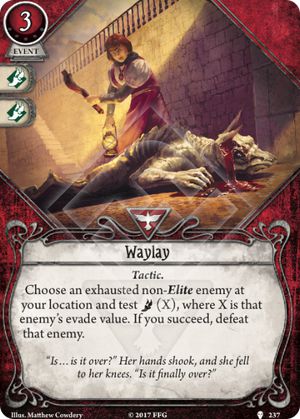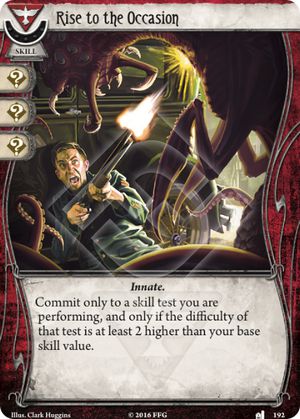
It's been years now since Lita Chantler and pals first confronted the Ghoul Priest all the way back in The Gathering, and the Striking Fear encounter set has been terrorizing us ever since. Are there any other cards that feel more like frenemies than these guys? They're familiar, adversarial, and you can always rely on them to show up for you at some point when you'd rather they didn't. But you can't stay mad at them for too long - after all, they're such a staple of the Arkham experience that the game just wouldn't be the same without them. It's like, "Oh Rotting Remains, you gave me yet another mental trauma - you rascal!"
With that said, it's this set's very ubiquitousness that merits its members a legitimate analysis. After all, these cards aren't restricted to a specific scenario, so you will run into them over and over again. As such, it's probably worth asking yourself what you need to include in your deck to deal with them specifically. What's worse is that they tend to appear in encounter decks alongside scenario-specific treacheries that amplify their nastiness.
The two general considerations in choosing what cards to include in your deck to deal with these are: (1) What investigator am I playing as? and (2) What difficulty am I playing on?
Of the three, Dissonant Voices is probably the most straightforward to analyze. Regardless of the game state, most of the time you're just going to eat this card. You should generally be playing your assets instead of holding onto them, so hopefully this card hits you after your board is already set up. The loss of playing events hurts a little more, but should hopefully not affect your turn too drastically. After all, you always have other things you can be doing, such as drawing a card, punching an enemy, or investigating your location. And the card disappears at the end of the round anyway - with no check! So grit your teeth and deal with it.
The other two cards in the set - Frozen in Fear and Rotting Remains - are significantly more troublesome. Even though neither possesses an unconditional penalty (you can escape unscathed if you pass a skill check), the punishment for failing is harsh, and can often be deadly. In addition, the nastiness of both of these cards scales upwards with the difficulty you are playing on. As to which card is worse? In my opinion, it's a toss up.
Frozen in Fear will almost always cause you to lose at least one action. It's uncommon to have a turn where you don't perform one of the listed actions (move, fight, or evade), though this will depend somewhat on your role on the team. In general this card is less of an upset to Seeker investigators, who will often be content to stay put and perform investigations, and who have access to other movement options such as Shortcut or Pathfinder. Guardians - who will usually be taking fight actions more than the other factions - are probably hit the hardest by this card.
Of course the worst part of Frozen in Fear is that you have to pass a will check to get rid of it. Here's where the number of players becomes an additional factor: On solo mode, each lost action is a much larger percentage of the total actions available to you; never mind the fact that it can be tougher to pass that accursed check without any teammates to help you out by committing cards. Failing this test more than once in solo mode is going to be game over a lot of the time.
As for Rotting Remains, this card scales in a particularly nasty way with the difficulty level. Not only is it harder to pass the check at the tougher levels, but the higher variance will on average lead to worse results for a failed check, even if you're boosting to the corresponding sweet spot. For example, if you are playing on Easy and boost yourself to +1, you'll only take 1 horror for drawing the worst negative token (in this case a -2, ignoring special tokens). On the other hand, if you are playing on Expert and boost yourself to +4 (as you should), you'll take the full 3 horror for drawing the -8 token.
As for how to deal with these cards, you have three basic options:
And this is where your choice of investigator comes into play:
-
Out of all the factions, Mystics have the easiest time dealing with these cards. Ward of Protection cancels out both the ill effects of the treachery, and spares you a draw from the chaos bag. Scrying can assign the treacheries to the best-equipped investigator. In the event they do perform the skill test, their naturally higher Willpower grants them the highest chances of passing. And if they do end up taking horror from Rotting Remains, they tend to have higher-than-average sanity to soak it. Agnes Baker can even weaponize this particular card if she gets hit.
-
Seekers are in a similar situation. They have Forewarned and the excellent Dr. William T. Maleson to help them manage the encounter deck. That aside, their Willpower is above average and their sanity totals are the highest of any faction, so performing the skill test will rarely be the end of the world for them. And of course Higher Education exists, so there's that. Heck, Daisy and Norman are half Mystic, so they have all of the above options available to them as well. The one oddball is Joe Diamond who would really prefer to avoid these cards altogether with Forewarned and even On the Hunt. Also of particular note is Logical Reasoning which functions as both a prophylactic and a panacea for this entire encounter set.
-
Rogues and Survivors are a real mixed bag and have to be considered on a case by case basis. Sefina Rousseau can basically use the Mystic analysis above, and William Yorick's infinite supply of teddy bears will keep him safe from any Rotting Remains (although it begs the question why a digger of graves would be disturbed by this imagery in the first place). But then you have your Skids
and your Finns for whom an unfortunately-timed Rotting Remains is really going to hurt. As such, "You handle this one!" is worth a strong consideration for just such an occasion.
-
Finally Guardians are the ones who really don't want to draw these cards. With their fair-to-middling Willpower, they are going to fail that check fairly often and the punishment is the most painful for them to boot. A Rotting Remains gone wrong is GG for Mark Harrigan or Roland Banks a large percentage of the time, especially when combined with a special token that also inflicts horror. A failure on a Frozen in Fear test is also a serious problem, as you'll often be swallowing all your teammates cards on subsequent checks, since Guardians tend to not pack lots of cards with icons. If I'm running multiple Guardians in a group, I tend to choose Leadership over Unexpected Courage specifically to deal with the Striking Fear set when it comes up. Anyway, On the Hunt is probably the most efficient way of dealing with these cards as it allows you to (temporarily) avoid them altogether. Carolyn Fern is of course the exception, since she doesn't like fighting and can deal with the horror better than almost any other investigator in the game.
A quick note about Roland Banks specifically: these treacheries are so bad for him a higher difficulties that I always opt for Dr. William T. Maleson over say, Art Student as a secondary Ally when moving up from Standard to Hard. Keep your fingers crossed that you draw an enemy to punch so you Roland can get his clue back!
In summary, the Striking Fear set embodies everything we love and hate about the encounter deck. I'm sure it will continue to make our lives miserable for years to come, so we might as well be prepared for it.




